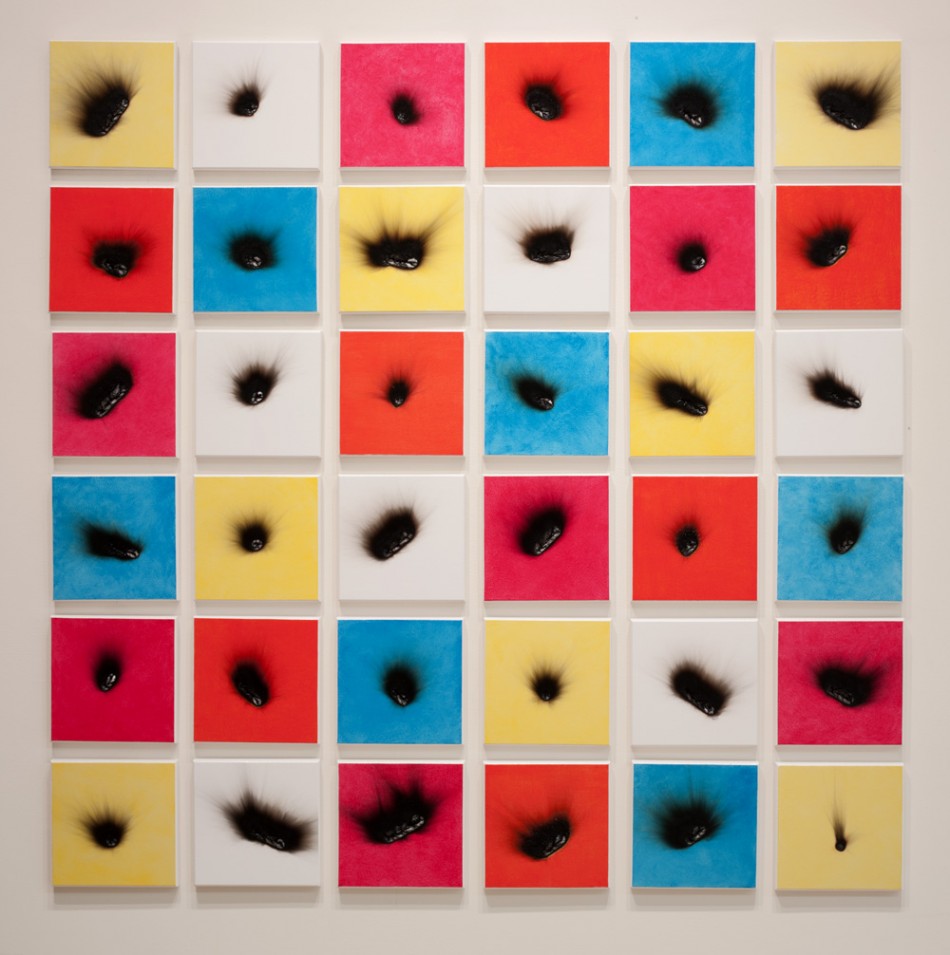
Playing with Fire: Charles Ross at Gerald Peters Gallery
As if playing at demigod status, Charles Ross’s show at Gerald Peters Gallery, Solar Burns, is a collection of wooden planks that looks like they’ve burned in some boisterous game of Greek mythology. Ross uses a large lens to burn the path of the sun into each piece of wood and each wooden center bears a spot of smoldered wood that gapes open like an exposed wound. Far from revealing blood clots or human matter, these are wounds of elemental warfare—as if a grand puppet show of Rock, Paper, Scissors, Shoot went a little haywire.

The squares themselves are small and manageable, human scale. They measure ten-by-ten or smaller and when arranged together comprise a monumental image. Solar Burn Week shows the vestiges of three week-long symposia, where Ross funneled the sun’s rays all day from 8:30am to 4:30pm. Here the panels are rectangles measuring ten-by-thirty inches each and placed together in three columns of seven to fill a wall with its astrological calendar. Week one belongs to Capricorn, two to Aries and three to Cancer. Each rectangle is painted white using an alcohol-based paint that Ross chose for its ability to reveal the burn’s halo effect of emanating black rays. This spray of heat is the best part of the wound; often pushing toward yellow/orange at its edges to remind the viewer how close these neighboring regions came to burning. Hung horizontally, each wooden plank bears a slash from side to side where the sun left its eight-hour score against the pristine background in a subtle arc shape. One board is left blank because it was cloudy that day.

Originally a mathematician, Ross started making art while studying at UC Berkeley where he received his BA in Mathematics in 1960 and two years later received an MA in Art. Apparently math and art still combine like the stars and the moon as Ross follows the long tradition of applying numerical calculations to artistic creation in hopes of yanking some sense out of the world around us. Melancholia II: Dürer’s Magic Square x 4 is a large square comprised of sixteen ten-by-ten inch wooden squares, each burned by the sun for the number of minutes that corresponds to the number in the magic square in Albrecht Dürer’s “Melancholia.” An engraving from 1514, “Melancholia” is an image of a godlike man (revealing archangel wings) who sits thinking, perhaps puzzling. Tools of mathematics are sorted everywhere and behind his head over his shoulder like a cartoon thinking bubble sits the mysterious magic square made famous by Dürer. Each row of numbers, the diagonals and the four numbers in the center equal 34. Likewise, Ross’ Melancholia II is a green and white checkerboard of solar burns temporally registering Durer’s magic square by use of our planetary star.

There is something tragically romantic about an artist who plays with the sun, making art imagined by mystic numbers like Ross’ most beloved—number 137. (Presumably the “God number,” 137 exceeds explanation here except to say that in Kabbalah, the word Kabbalah equals 137.) Either it’s tragic that our world is in danger and Ross’ solar burns remind me of that gaping hole in the ozone layer and/or it’s tragic that there’s still a void of answers to all the questions. Additionally, the artist is playing with fire and the tragedy becomes one of romance where Ross gets burned like Icarus whose wax wings melted as he fell from the sky and drowned. It’s all so fantastical but Greek mythology aside, the artist here succeeds in delivering if not mystic truths than at least beautiful ruins made in some mortal’s game of heliocentric Capture the Flag.
